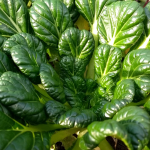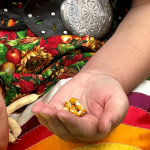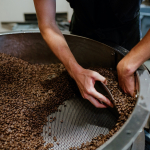Climate Mitigation through Agroforestry

Emily Lorenz
This article first appeared on the FarmFolk CityFolk website and is printed here with gratitude.
Agroforestry integrates trees or shrubs with other crops and/or livestock. Trees can capture greenhouse gases through their branches, leaves, trunks, and roots, making them an important climate solution and aid in reducing emissions in agriculture. In addition to sequestration, trees improve soil structure with their root systems and add nutrients to the soil with fallen leaves. Trees prevent flash flooding on agricultural lands by slowing down water with their root systems. Agroforestry systems create diversified habitats for wildlife with hedges, fruit trees, dead wood, grazing animals and other crops. Woodlands are a place for climate solutions, beneficial outcomes for farmers, and a calming space to promote farmer well-being.
George Powell, previously employed by the University of Alberta and the Ministry of Forests research program, is now an independent consultant offering his depth of knowledge as an agrologist specializing in integrated production systems. Powell describes agroforestry as, “a whole family of land-use practices that in some way involve the purposeful integration of trees or shrubs with other agricultural production, other crops or with livestock systems.” Agroforestry systems are diverse and complex and often “not defined by what you’re producing, but more like how you’re producing it,” says Powell. Clear cutting for agriculture and eliminating native tree species has severe environmental consequences. Powell says, “That’s probably one of the bigger environmental issues we’re still facing in BC. A lot of small and large stream networks [are suffering]. Forest cover was eliminated up to the water’s edge, which has big consequences for water quality and wildlife habitat.”

Maintaining and planting woody plants has beneficial results for our climate. Trees and other woody perennials are a significant source of carbon capture. Powell has experience testing carbon levels in test plots of agroforestry models. He says, “Every tonne of woody material that you grow, about 50% of that is carbon. Large perennials turn over about 50% of their fine root material every year, which means huge soil organic carbon pools could be created. It’s a sequestration monster.” There are benefits for farmers to maintain trees on their land; benefits that include savings on time and labour as well as increasing soil health. Powell says, “With a forested system cleared for agriculture, the more trees and shrubs you retain there, the more you’re mimicking that structural setting and natural flows. The nutrient dynamics and the water dynamics completely change when you bring trees and shrubs into the picture. The soil erosion risks drop off because you have those deep-rooted components that you don’t have from most crops.”
Not only are trees and large woody perennials a climate solution, but agroforestry is an effective adaptation tool for farmers. Powell says, “I think the real strength of agroforestry for BC is in adaptation.” One of the largest benefits of agroforestry modelled farms is the diversification of species on the land. Powell says, “Having a diverse range of things that you’re producing is your first best strategy against climate change and annual variability in the climate extremes.” Windbreaks and temperature control are beneficial results of trees. Powell encourages the use of trees and shrubs for soil moisture conservation in terms of windbreaks.
Farmers can adopt several categories of agroforestry to diversify and strengthen their agricultural system. The list includes alley cropping, silvopasture, shelterbelts, hedgerows, timberbelts, forest farming, and integrated riparian management. Each method offers unique benefits and is typically chosen according to the qualities of the farming operation.

The integration of livestock and forest systems through silvopasture is a popular method of integrating trees on a farm. The approach of blending trees and animals in a system has numerous positive effects that benefit animal livelihood and our climate. In the winter, animals have an area to shelter from harsh temperatures and weather that is too extreme for them. Powell notes, “Trees and shrubs are largely water, they become big pools of long wave radiation and they radiate out that energy all around them. In wildlife terms, it’s called a thermal cover and the same principles apply to livestock.” Powell suggests setting up “living barns”, which are, “block or strip cuts into forests where you winter your animals in those strips and they benefit from the sheltering from the wind and the thermal radiation coming from the trees.” More importantly, in summer, shade is an important benefit that animals receive from tree cover. Heat stress occurs when an animal takes on more heat than its capacity to lose it. When they begin to experience heat stress, they seek shelter which a forest can provide easily.
Trees and shrubs offer a variety of nutrients that animals may not otherwise get. Fallen leaves and species that produce nuts and berries are nutritious to an animal’s diet. Beyond the numerous reasons that forested areas benefit livestock, the simplest encouragement is that certain species are meant to be integrated with trees. Powell says, “Livestock species were selected from forest-dwelling species. Cattle and chicken’s native predecessors are forest species. So they’re just happier with forest cover around. There are definite animal welfare benefits there.” Heather Young from Under the Oak Farm is preparing her farm for a silvopasture system. She strategically plants species of nut trees with the native and already established forest species and will introduce cattle onto in the coming years. Young plans to provide her cattle with the benefits of shelter from extreme climate variability and nutrients from the fallen nuts and foliage from the trees.
Forest farming is a unique technique for farmers to cultivate a high-value production crop under a canopy of trees. In addition to maintaining their forested area, they have planted numerous fruit trees with crops underneath to create a food forest. There are numerous benefits to forest farming. Young says, “In nature, trees grow with an understory of plants. If we reproduce that and let nature do its thing, it makes our life easier. We don’t have to weed as much, we don’t need to use nitrogen fertilizer, especially if you have nitrogen fixers. And, the trees provide habitat for birds that will eat your bugs.”

Many small-scale farmers use alley cropping to optimize space on their farms. This agroforestry method involves planting rows of trees and/or shrubs to intentionally create alleys where crops are produced. For farmers who row-crop, this is a unique way of increasing income using a different profit source than their regular crops. Alley crops reduce erosion and can be a positive use of space where other crops cannot be planted. Strategically planted rows of trees can act as windbreaks and microclimates for other crops and livestock, increasing yield and quality of life. Alley cropping increases biodiversity and provides additional habitat for wildlife.
One or more rows of closely spaced trees and/or shrubs planted at the right angles to protect crops, soils, animals, and buildings from wind pressure are referred to as shelterbelts and hedgerows. These can be utilized along fence lines or as buffers between crops or animals. According to Powell, we need to restore the damaged waterways caused by agricultural clearing. He suggests, “Restoring those [waterways] in an agricultural setting would involve reestablishing buffers,” like hedgerows and shelterbelts. Rainer Krumsiek at Big Bear Ranch uses shelterbelts and hedgerows on their farm to create windbreaks for both their animals and wildlife. For Krumsiek, agroforestry is an important part of their farming operation. Krumsiek says, “Agroforestry helps with erosion control and nutrient balance. The moisture from snow accumulation and the fallen leaves from trees bring nutrients to the soil.”
Whichever approach farmers choose, agroforestry is regarded highly as a climate solution in agriculture. Trees are massive carbon sinks, add biodiversity to the farm ecosystem, and provide wildlife habitat, all contributing to climate mitigation. Farmers like Young note, “Our ability as agriculture to sequester carbon is more far-reaching than any technology we have so far.” Agroforestry systems benefit farmers in many ways. This includes saving time, labour, and financial costs over time; reducing erosion and increasing soil health; providing a natural canopy and windbreak for grazing livestock and poultry; providing nutrients to the ground below; spreading the risk in agriculture and increasing climate change variability.
When considering an agroforestry approach on a farm, it’s important to keep in mind that not all areas are appropriate for planting trees. Powell says, “When trees are applied to an area, you need to understand what varieties are native to that area and ecosystem, whenever possible. If the goal is to integrate livestock, it’s important to consider that not all livestock are appropriate for certain areas and species of trees. Find a local expert, speak to the local council and consult with First Nations communities.”
Approaching agroforestry by studying local agroecology is a good first step. Natural systems are thriving for a reason and farmers can learn a lot from natural ecosystems. Powell says, “It’s less energy to maintain a system the more of the natural cycles and processes you can retain. That’s what agroforestry does.” This approach can hugely benefit our climate, especially if more agricultural lands in BC incorporate agroforestry practices. Young says, “I am a firm believer that if we change parts of how we live, our emissions would decrease. A big part of how we live is choosing better agricultural practices.”
farmfolkcityfolk.ca
Emily Lorenz is the Engagement Coordinator for FarmFolkCityFolk and is passionate about supporting farmers and ranchers across BC.
Feature image: Alders fix nitrogen in wooded areas. Credit: Farm Folk City Folk.










